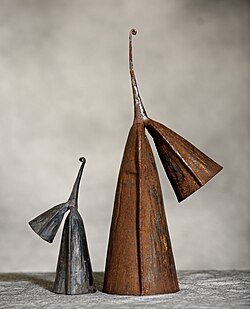Cross-rhythmic structure
The ethnomusicologist David Locke states: "Cross-rhythm pervades Ewe drumming." [2] In fact, the overall rhythmic structure is generated through cross-rhythm. [3] Cross-rhythm was first identified as the basis of sub-Saharan rhythm in the early writings of A.M. Jones, and was later explained in great detail in lectures by the Ewe master drummer and scholar C.K. Ladzekpo, and in the writings of Locke.
At the center of a core of rhythmic traditions within which the composer conveys his ideas is the technique of cross rhythm. The technique of cross rhythm is a simultaneous use of contrasting rhythmic patterns within the same scheme of accents or meter.
In Anlo-Ewe cultural understanding, the technique of cross rhythm is a highly developed systematic interplay of varying rhythmic motions simulating the dynamics of contrasting moments or emotional stress phenomena likely to occur in actual human existence.
As a preventive prescription for extreme uneasiness of mind or self-doubt about one's capacity to cope with impending or anticipated problems, these simulated stress phenomena or cross-rhythmic figures are embodied in the art of dance-drumming as mind-nurturing exercises to modify the expression of the inherent potential of the human thought in meeting the challenges of life. The premise is that by rightly instituting the mind in coping with these simulated emotional stress phenomena, intrepidity is achieved.
Intrepidness, or resolute fearlessness, in Anlo-Ewe view, is an extraordinary strength of mind. It raises the mind above the troubles, disorders and emotions which the anticipation or sight of great perils is calculated to excite. It is by this strength that ordinary people become heroes, by maintaining themselves in a tranquil state of mind and preserving the free use of their reason under most surprising and terrible circumstances—Ladzekpo (1995: Web). [4]
3:2 (hemiola)
The most fundamental cross-rhythm in Ewe music, and Sub-Saharan African music traditions in general, is three-against-two (3:2), or six-against-four (6:4), also known as a vertical hemiola. The cycle of two or four beats are the main beat scheme, while the triple beat scheme is secondary. Ladzekpo states: "The term secondary beat scheme refers to a component beat scheme of a cross rhythm other than the main beat scheme. In a similar manner as a main beat, each secondary beat is distinguished by measuring off a distinct number of pulsations. A recurrent grouping of a number of these beats in a musical period forms a distinct secondary beat scheme." [5]
We have to grasp the fact that if from childhood you are brought up to regard beating 3 against 2 as being just as normal as beating in synchrony, then you develop a two dimensional attitude to rhythm… This bi-podal conception is… part of the African's nature—Jones (1959: 102) [6]
Novotney observes: "The 3:2 relationship (and [its] permutations) is the foundation of most typical polyrhythmic textures found in West African musics." [7] 3:2 is the generative or theoretic form of sub-Saharan rhythmic principles. Agawu succinctly states: "[The] resultant [3:2] rhythm holds the key to understanding . . . there is no independence here, because 2 and 3 belong to a single Gestalt." [8]

3:8
The following bell pattern is used in the Ewe rhythm kadodo. [9] The 24-pulse pattern crosses the barline, contradicting the meter with three sets of five strokes, across eight main beats (two measures of four main beats each). The three single strokes are muted. The kadodo bell pattern is an embellishment of three "slow" cross-beats spanning two measures, or three-over-eight (3:8). Within the context of a single four-beat cycle (single measure), the cross-rhythmic ratio is 1.5:4.




